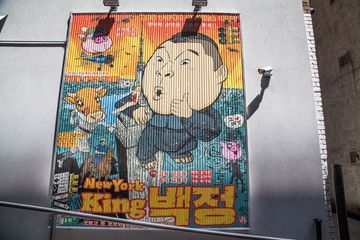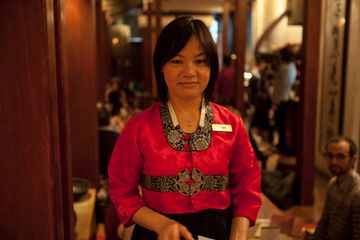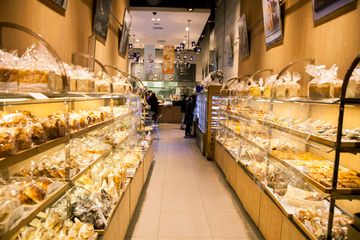It appears that only a few short weeks after opening Osamil in the early fall of 2016, the three partners of Nomad Izakaya have another hit on their hands. At 5: 00pm when Tom, the photographer for Manhattan Sideways, and I walked in, there were a few people milling about at the impressive white marble bar. By the time we left, about an hour and a half later, there was not a seat to be had upfront, and the tables for dinner were rapidly being filled. Both Nathan, the manager, and Moku, one of the owners, greeted us with big smiles, enthusiastically showing off the beautiful decor. Staring at the front mural - with 5th Avenue and 31st Street signs painted on it - Nathan enlightened us that O-sam-il means 5, 3, 1 in Korean. From their doorway, one can see the real signs outside. The numbers have added significance, because in addition to being on 5th and 31st, the restaurant's address is 5 West 31st. When the team first found this space, they had to strip everything down. When they came upon the brick wall on one side, they decided to sand it and leave it exposed. The end result is a checker board design that is strikingly different than other spaces I have seen. A Korean friend of Moku's did the mural on the rest of the wall. "We told him to do whatever he wanted - to use his imagination. " Moonsub Shin did just that, creating a soft gray design that is soothing and beautiful. The wood tables and short stools are spread down the middle of the restaurant with a few booths along the edges. Liquor lockers span the entire opposite wall, filled with customer's personal alcohol. Be it a fine bottle of Scotch or a vintage wine or bourbon, customers are welcome to store whatever they would like in their secured cubby - for a small corkage fee. Straight in the back lies the open kitchen where Chef David Lee performs his magic. Osamil is different from more traditional Korean eateries found just a few blocks away. Here they are striving to be more "modern and upscale" while still being reminiscent of a typical Korean barbecue restaurant. After showing us around and chatting about Osamil, Nathan and Moku invited Tom and I to take a seat at the bar to await some dishes that we could photograph. Little did we realize that the presentation of these dishes would last for a delightful forty-five minutes. The first to arrive was a sizzling plate of cured shrimp, sauteed shishito peppers with broccoli rabe, and beef tartar. Each dish was presented on a unique plate as a culinary work of art. It was not long before a medley of grilled mushrooms and a large marinated lamb chop covered in a mix of herb and pine nuts were placed in front of us. While we watched Gelo, the bartender, whip up several intriguing cocktails, a 100-year-old oak board was put before us with a very large, crispy port shank. A knife and fork stuck out from the top and the shank was surrounded by a shaved apple salad, lettuce leaves, and three small bowls with an array of pickled relishes. Once Tom had finished taking photos of this impressive meal for two, he was instructed to grab a lettuce leaf and fill it with meat, salad, and a relish of his choice. It was great fun and, he assured me, very tasty. There is no doubt that Osamil is off to a fine beginning.





